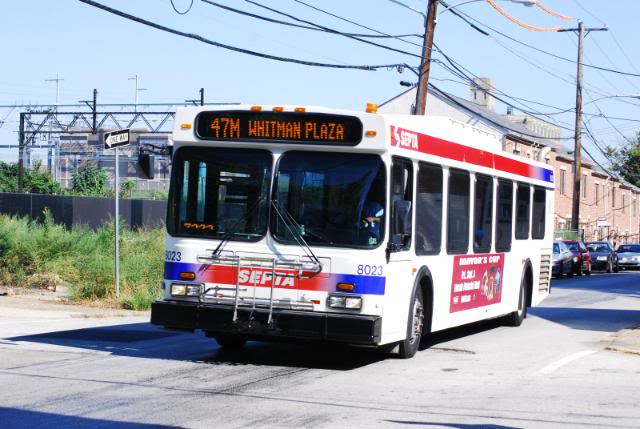Transit First pilot program to hit streets next month

It’s been more than a year in the making, but Transit First is about to hit the streets of Philadelphia.
The city and SEPTA have chosen Route 47 to be the standard bearer for the project, which aims at improving transit speeds throughout the system.
SEPTA is one of the slowest transit systems when compared with its peers, and this pilot project ― which is slated to run for six months beginning April 18 ― is meant to change that.
Route 47, SEPTA’s third-busiest surface route, is also one of its slowest, with an on-time performance of less than 75 percent.
And as anyone who rides the 47 during rush hour can attest, buses also bunch together and often become too crowded to even pick up riders.
The pilot program will focus on the southern portion of the route ― which stretches runs from Whitman Plaza in South Philadelphia to Olney ― where many of the problems occur.
About half of the stops south of Market Street will be removed, eliminating boarding time and allowing buses to travel faster ― though no stops adjacent to senior centers are being taken away.
Three bus stops will also be moved to the far side of intersections in the hope that fewer buses will get caught behind red lights while riders board.
To speed up boarding during rush hour, buses will allow riders with passes to board from the rear at 7th and Washington in the morning and at 8th and Market in the afternoon ― similar to what happens at the bus stop in front of the Municipal Services Building. SEPTA will have loaders on hand to check passes.
The Streets Department will alter garbage and recycling pickups to avoid peak hour traffic on 7th and 8th streets, where the route runs.
And to ensure that each bus is traveling as fast as it can ― rather than on a schedule ― buses will run on a headway system. They’ll depart from Whitman Plaza every six minutes.
Taken together, the changes represent a way to hopefully improve service without spending much money, according to Andrew Stober, chief of staff for the Mayor’s Office of Transportation and Utilities, which is working with SEPTA on the Transit First initiative.
Originally, the city and SEPTA were looking at more expensive ways of speeding up buses, like installing a transit signal priority system, which would detect approaching buses and change traffic signals to allow them to get through intersections.
But tight budgets, affecting both the city and SEPTA, forced them to look at cheaper options, Stober said.
Route 47 was chosen, he said, to serve as “a model” for other north-south routes through Center City. Interventions that speed up service and prove popular may be extended to other bus routes.
To that end, there’s an aggressive effort to see how the changes affect performance and customer attitudes.
The Delaware Valley Regional Planning Commission did a survey of the route last spring, sending out workers armed with GPS devices to ride buses and noting the cause of any delays. The city also conducted a customer survey of riders.
(Stober was surprised at how satisfied they seemed and thinks the results might be more an indication of learned helplessness than true happiness with the route.)
The same surveys will be conducted again during the pilot to measure progress. “We don’t know how all these things will add up,” Stober said.
While that’s true, hopes are high for noticeable improvements.
Michael Liberi, SEPTA’s chief surface transportation officer, predicts the city and SEPTA will decide to make the pilot permanent before December. He thinks the lessons learned could also be applicable to east-west routes, like the 21 and 42, that have heavy ridership but poor on-time performance.
Greg Krykewycz, a DVRPC senior transportation planner who’s worked on the Transit First project, also notes that moving to headway-based scheduling alone might result in noticeable improvements because it removes any “padding” from the previous schedule. Los Angeles’ transit agency, for instance, saw as much improvements from moving to this type of scheduling as from adopting a transit-signal priority system.
Aware that previous Transit First efforts foundered when encountering political opposition, the city and SEPTA are making aggressive outreach efforts.
They won the support of City Councilman Frank DiCicco, whose district includes the South Philadelphia neighborhoods served by the route, and are in the process of visiting neighborhood association meetings to get the word out.
Wendy Green-Harvey, who’s handling SEPTA’s public outreach for the project, said the groups have so far been receptive to the changes.
(One Pennsport Civic Association (http://www.pennsportcivic.org/) board member told this reporter that the plan would be worth it if service is improved.)
SEPTA is also distributing flyers at businesses along the route and has started up a website (http://www.septa.org/service/bus/47pilot/index.html) to get the word out, Green-Harvey said.
Perhaps even more important than any service improvements, the pilot represents an attempt to turn around the historically antagonistic relationship that existed between the city and SEPTA.
All of the parties involved have stressed the importance of that new spirit of cooperation in getting the pilot program up and running.
It was “a real team effort,” Krykewycz said.
Contact the reporter at acampisi@planphilly.com
WHYY is your source for fact-based, in-depth journalism and information. As a nonprofit organization, we rely on financial support from readers like you. Please give today.






